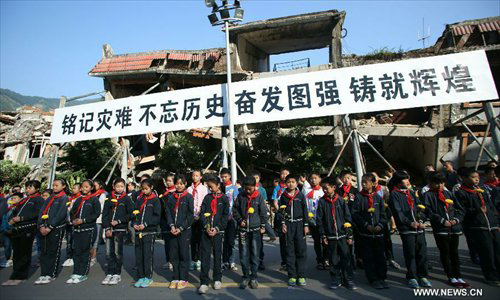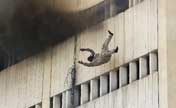
 |
| Pupils mourn for victims who died in a massive earthquake five years ago in the old county seat of Beichuan, southwest China's Sichuan Province, May 12, 2013. A memorial event was held in Beichuan on Sunday to mark the fifth anniversary of the deadly earthquake which havoced Sichuan on May 12, 2008. (Xinhua/Wang Shen) |
China marked the fifth anniversary Sunday of the 8.0-magnitude Wenchuan earthquake in Sichuan Province by mourning for some 70,000 victims and holding a post-quake relief drill, right after a 7.0-magnitude quake struck another part of the province on April 20.
Mourning for the victims of the two earthquakes was seen across Sina Weibo, while public drills on post-quake relief work and disaster reduction took place nationwide on Sunday to mark the anniversary.
Disaster reduction pamphlets were distributed, the location of public shelters was publicized and information boards containing first-aid tips and emergency response advice were put up across the country.
The country's ability to launch relief efforts has been tested following the Lushan earthquake and the reaction this time was widely applauded.
The provincial government launched a contingency plan 10 minutes after the quake, while the first team of rescuers set off for the quake-hit area within 30 minutes, the Xinhua News Agency reported.
Unlike the Wenchuan quake when people across the country were strongly encouraged to arrive at the quake-hit area and offer help, media advocated sensible volunteerism and avoid clogging up roads and delaying rescue teams.
Gao Jianguo, a researcher at the Institute of Geology of China Earthquake Administration, told the Global Times that the habit of constructing safe buildings by following stringent codes has been strengthened.
"But problems are still there," Gao said. "Even though the codes have been set up, chances are that during construction they are not well followed."
Figures released Saturday by the Sichuan Provincial Bureau of Statistics show that the economic growth of 39 hardest-hit counties in the Wenchuan earthquake increased at an annual average of 15 percent from 2009 to 2012, exceeding Sichuan's average growth by 0.7 percentage points.
Outside this good news, reconstruction in the affected areas has been frustrating due to charges of corruption. An audit report assessing the reconstruction work in affected zones by the National Audit Office in 2012 showed that 1.4 billion yuan ($228 million) of the funds had been embezzled or illegally transferred.
Zhu Lijia, a public management professor at the Chinese Academy of Governance, told the Global Times that lessons should be learned by first standardizing all procedures during the reconstruction, including design and hiring contractors, as the work in zones following the Lushan earthquake has just kicked off.
"The whole process should be made public and more transparent, since it involves charity funds," he said. "Authorities should accept supervision by people from the affected areas, answer inquiries from the media and publicize figures in a timely manner."


















![]()
